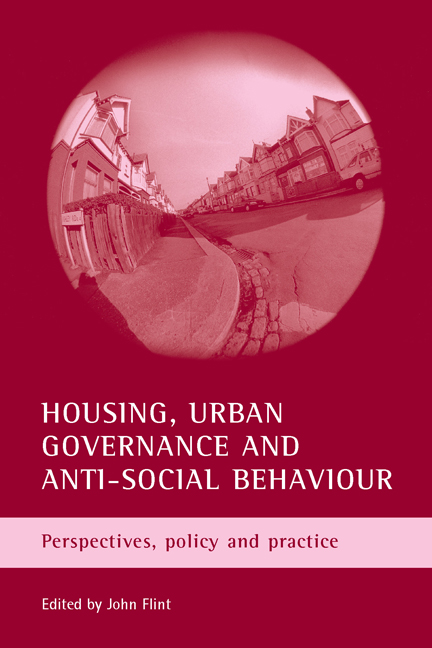Book contents
- Frontmatter
- Contents
- List of tables, figures and photographs
- Acknowledgements
- Notes on contributors
- Introduction
- Part 1 The definition and construction of anti-social behaviour in the UK
- Part 2 Legal techniques and measures utilised by social landlords to address anti-social behaviour
- Part 3 The emerging mechanisms of addressing anti-social behaviour in housing governance
- Part 4 Studies of housing and anti-social behaviour from an international perspective
- Index
fifteen - Residential stability among adolescents in public housing: a risk factor for delinquent and violent behaviour?
Published online by Cambridge University Press: 15 January 2022
- Frontmatter
- Contents
- List of tables, figures and photographs
- Acknowledgements
- Notes on contributors
- Introduction
- Part 1 The definition and construction of anti-social behaviour in the UK
- Part 2 Legal techniques and measures utilised by social landlords to address anti-social behaviour
- Part 3 The emerging mechanisms of addressing anti-social behaviour in housing governance
- Part 4 Studies of housing and anti-social behaviour from an international perspective
- Index
Summary
Introduction
The private housing market exposes working tenants to great instability. Private housing residents are shuttled around by rezoning, redevelopment, renewal, evictions, and slumlord neglect. Residents flee intolerable sanitary conditions, rats that bite their children, and other domestic hazards. In this context public housing remains an oasis of stability not simply for the dependent single-parent families, but also for the poor and working households who at the very least can rely on their housing status when all else is in flux. (Venkatesh, 1997, p 36)
Renewed interest in understanding the links between public housing and crime is evidenced by recent research in Australia (Weatherburn et al, 1999), Canada (DeKeseredy et al, 2003), the UK (Bottoms and Wiles, 1986; Bottoms et al, 1992; Flint, 2002), and the US (Popkin et al, 2000; Santiago et al, 2002; Ireland et al, 2003). The general consensus is that areas where public housing is located have higher rates of official crime or reported victimisation. The opinion that public housing is crime-ridden is reflected in several local and federal initiatives in the US that are directed at controlling crime and drugs in and around public housing, including local police actions in public housing (Popkin et al, 1999; Barbrey, 2004), the Public Housing Drug Elimination Program (for example, Popkin et al, 1995), and the One-Strike and You’re Out initiative (Dzubow, 1996; Hellegers, 1999), as well as efforts to disburse assisted housing out of the most impoverished areas of the city via HOPE VI (Naparstek et al, 2000; Popkin, 2003) and the Moving to Opportunity Demonstration Project (Briggs, 1997; Popkin et al, 2002).
However, Ireland et al (2003) found that self-reported involvement in property and violent crime among adolescents residing in public housing in Rochester, New York and Pittsburgh, Pennsylvania was not statistically significantly higher than among adolescents not in public housing. Their cross-sectional study did, however, find that in large developments or high-rise units in Pittsburgh the level of selfreported violence was quite high, particularly during late adolescence.
In this chapter we attempt to ascertain whether living in public housing for a relatively long period of time is more behaviourally detrimental than living in public housing for a relatively short period of time.
- Type
- Chapter
- Information
- Housing, Urban Governance and Anti-Social BehaviourPerspectives, Policy and Practice, pp. 301 - 324Publisher: Bristol University PressPrint publication year: 2006
- 1
- Cited by



